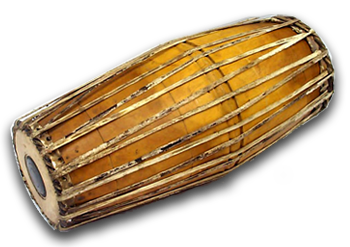It‘s a two headed drum belonging to percussion instrument family largely and is played in southern part of India. Over a period of time Mridangam has evolved and is made of different types of woods. The body is made from the wood of the jackfruit tree. The two openings of the drum are covered with the skin of a goat and tied to each other with leather straps across the drum.
These straps are tied tight to stretch out the circular membranes allowing them to resonate when struck. These two membranes are not similar to each other, hence it creates bass from one side and treble sounds from other side.
The smaller membrane produces tower pitched sounds when struck and the wider membrane produces lower pitched sound. The smaller membrane covered with goat skin is anointed with a a black disc made from rice flour, ferric oxide powder and starch. It is known as Satham.
Before using for any performance the leather covering the wider membrane is made moist. The player tunes the instrument by changing the tensions of the leather straps

The Mridangam is placed parallel to the floor. The right handed player strikes the smaller membrane with his right hand and the larger membrane with his left handed and vice-versa. It rests upon the right foor and the left leg is bent and rests again the body of the drum.
Mridangam is largely used in carnatic music performances across southern India and now all over the world. It is also used in “Yakshagana†orchestra . In Hindu mythology, sculptures and in paintings mridangam is often shown as the instrument used by Lord Ganesha and also by Nandi, the vehicle of Lord Shiva during the Lord Shiva‘s “Tandava†dance. Mridangam is also known as “Deva Vaadyam†means Divine Instrument. It also plays a wide role Newa music. It is also played in Carnatic musical shows in countries as Srilanka, Singapore, Malaysia, Australia, United Kingdom, Canada and United States and hence it is nicknamed as “The king of Percussionsâ€.
